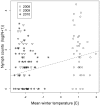Variable strength of forest stand attributes and weather conditions on the questing activity of Ixodes ricinus ticks over years in managed forests
- PMID: 23372852
- PMCID: PMC3555926
- DOI: 10.1371/journal.pone.0055365
Variable strength of forest stand attributes and weather conditions on the questing activity of Ixodes ricinus ticks over years in managed forests
Abstract
Given the ever-increasing human impact through land use and climate change on the environment, we crucially need to achieve a better understanding of those factors that influence the questing activity of ixodid ticks, a major disease-transmitting vector in temperate forests. We investigated variation in the relative questing nymph densities of Ixodes ricinus in differently managed forest types for three years (2008-2010) in SW Germany by drag sampling. We used a hierarchical Bayesian modeling approach to examine the relative effects of habitat and weather and to consider possible nested structures of habitat and climate forces. The questing activity of nymphs was considerably larger in young forest successional stages of thicket compared with pole wood and timber stages. Questing nymph density increased markedly with milder winter temperatures. Generally, the relative strength of the various environmental forces on questing nymph density differed across years. In particular, winter temperature had a negative effect on tick activity across sites in 2008 in contrast to the overall effect of temperature across years. Our results suggest that forest management practices have important impacts on questing nymph density. Variable weather conditions, however, might override the effects of forest management practices on the fluctuations and dynamics of tick populations and activity over years, in particular, the preceding winter temperatures. Therefore, robust predictions and the detection of possible interactions and nested structures of habitat and climate forces can only be quantified through the collection of long-term data. Such data are particularly important with regard to future scenarios of forest management and climate warming.
Conflict of interest statement
Figures



Similar articles
-
Influence of climatic factors on Ixodes ricinus nymph abundance and phenology over a long-term monthly observation in Switzerland (2000-2014).Parasit Vectors. 2018 May 8;11(1):289. doi: 10.1186/s13071-018-2876-7. Parasit Vectors. 2018. PMID: 29739424 Free PMC article.
-
Abiotic predictors and annual seasonal dynamics of Ixodes ricinus, the major disease vector of Central Europe.Parasit Vectors. 2015 Sep 18;8:478. doi: 10.1186/s13071-015-1092-y. Parasit Vectors. 2015. PMID: 26385470 Free PMC article.
-
A multi-level analysis of the relationship between environmental factors and questing Ixodes ricinus dynamics in Belgium.Parasit Vectors. 2012 Jul 25;5:149. doi: 10.1186/1756-3305-5-149. Parasit Vectors. 2012. PMID: 22830528 Free PMC article.
-
Sampling scale and season influence the observed relationship between the density of deer and questing Ixodes ricinus nymphs.Parasit Vectors. 2020 Sep 29;13(1):493. doi: 10.1186/s13071-020-04369-8. Parasit Vectors. 2020. PMID: 32993763 Free PMC article.
-
Questing Ixodes ricinus ticks and Borrelia spp. in urban green space across Europe: A review.Zoonoses Public Health. 2022 May;69(3):153-166. doi: 10.1111/zph.12913. Epub 2022 Feb 4. Zoonoses Public Health. 2022. PMID: 35122422 Free PMC article. Review.
Cited by
-
Ghosts of weather past? Impact of past and present weather-related factors on the seasonal questing activity of Ixodes ricinus nymphs in southwestern Finland.Parasit Vectors. 2025 Jul 14;18(1):283. doi: 10.1186/s13071-025-06911-y. Parasit Vectors. 2025. PMID: 40660308 Free PMC article.
-
Environmental drivers of Ixodes ricinus abundance in forest fragments of rural European landscapes.BMC Ecol. 2017 Sep 6;17(1):31. doi: 10.1186/s12898-017-0141-0. BMC Ecol. 2017. PMID: 28874197 Free PMC article.
-
Aggravation of Human Diseases and Climate Change Nexus.Int J Environ Res Public Health. 2019 Aug 6;16(15):2799. doi: 10.3390/ijerph16152799. Int J Environ Res Public Health. 2019. PMID: 31390751 Free PMC article. Review.
-
The Role of Environmental Factors in Lyme Disease Transmission in the European Union: A Systematic Review.Trop Med Infect Dis. 2024 May 15;9(5):113. doi: 10.3390/tropicalmed9050113. Trop Med Infect Dis. 2024. PMID: 38787046 Free PMC article. Review.
-
Climate change, biodiversity, ticks and tick-borne diseases: The butterfly effect.Int J Parasitol Parasites Wildl. 2015 Aug 28;4(3):452-61. doi: 10.1016/j.ijppaw.2015.07.001. eCollection 2015 Dec. Int J Parasitol Parasites Wildl. 2015. PMID: 26835253 Free PMC article.
References
-
- Gilbert L (2010) Altitudinal patterns of tick and host abundance: a potential role for climate change in regulating tick-borne diseases? Oecologia 162: 217–225. - PubMed
-
- Ostfeld RS (2009) Climate change and the distribution and intensity of infectious diseases. Ecology 90: 903–905. - PubMed
-
- Sæther BE (1997) Environmental stochasticity and population dynamics of large herbivores: A search for mechanisms. Trends in Ecology and Evolution 12: 143–147. - PubMed
-
- Bjørnstad ON, Grenfell BT (2001) Noisy clockwork: Time series analysis of population fluctuations in animals. Science 293: 638–643. - PubMed
-
- Boyce MS, Haridas CV, Lee CT, Boggs CL, Bruna EM, et al. (2006) Demography in an increasingly variable world. Trends in Ecology and Evolution 21: 141–148. - PubMed
Publication types
MeSH terms
LinkOut - more resources
Full Text Sources
Other Literature Sources

